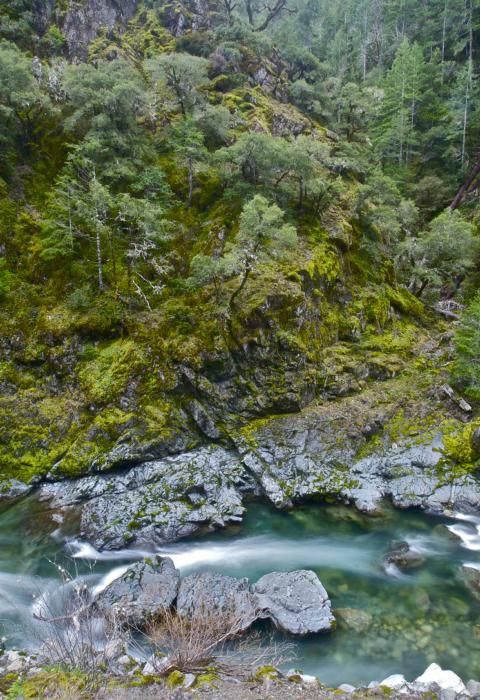Smith River
California
The Smith River was added to the National Wild and Scenic Rivers System in 1981 with an additional portion added in 1990. More than 300 miles of the Smith River drainage are designated wild and scenic, making it one of the most complete river systems in the National System. The emerald-green Smith River flows freely and naturally, without a single dam for its entire length. It is the only major system in California to do so.
The Smith River National Recreation Area (NRA) is located in the northwest corner of California and is managed by the Six Rivers National Forest. The Forest Service has been designated as the steward of the NRA to provide recreational opportunities and to manage this diverse area for all of its valuable resources. Below the National Forest, the Smith River and designated tributaries flow through Jedediah Smith Redwoods State Park and Redwoods National Park and on to the Pacific Ocean.
The NRA encompasses more than 450-square-miles of densely forested mountains, pristine botanical areas, remote wilderness landscapes, high-mountain lakes, and steep, rocky canyons. The river is an important stream for fish, with towering trees along its banks providing the shaded conditions necessary for cold-water species.
Designated Reach
January 19, 1981 and November 16, 1990. The segment from the confluence of the Middle Fork Smith River and the North South Fork Smith River to its mouth at the Pacific Ocean, including Rowdy Creek, Mill Creek, West Branch Mill Creek, East Fork Mill Creek, Bummer Lake Creek, Dominie Creek, Savoy Creek and Little Mill Creek. The Middle Fork from its the headwaters to its confluence with the North Fork Smith River, including Myrtle Creek, Shelly Creek, Kelly Creek, Packsaddle Creek, the East Fork of Patrick Creek, the West Fork Patrick Creek, Little Jones Creek, Griffin Creek, Knopki Creek, Monkey Creek, Patrick Creek, and Hardscrabble Creek. The Siskiyou Fork from its headwaters to its confluence with the Middle Fork, including the South Siskyou Fork of the Smith River. The South Fork from its headwaters to its confluence with the main stem, including Williams Creek, Eightmile Creek, Harrington Creek, Prescott Fork, Quartz Creek, Jones Creek, Hurdygurdy Creek, Gordon Creek, Coon Creek, Craigs Creek, Goose Creek, the East Fork of Goose Creek, Buck Creek, Muzzleloader Creek, Canthook Creek, Rock Creek, and Blackhawk Creek. The North Fork from the California-Oregon border to its confluence with the Middle Fork of the Smith River, including Diamond Creek, Bear Creek, Still Creek, the North Fork of Diamond Creek, High Plateau Creek, Stony Creek, and Peridotite Creek.
Outstandingly Remarkable Values
Fish
The Smith River, with its natural river flows, protected habitat, and lack of a strong hatchery influence, combine to make the Smith River the premier stronghold for salmon and steelhead in California.
Geology
The Smith River has one of the world’s best exposures of oceanic lithosphere (ophiolite).
Recreation
The Smith River is California’s only undammed river system. It is a jewel of whitewater, with three major forks and countless side creeks. It is also an attraction to swimmers and waders seeking the clear clean water.
Winter rains provide the whitewater conditions so avidly sought by kayakers. The Smith River abounds with Class IV and V rapids on all three forks and has many miles of steep creeking waters. Its miles of whitewater require a fairly high degree of technical skills by the boater. Once the three forks join to form the mainstem, the land levels out, and the last 16 miles to the ocean present less demanding conditions (Class I-II in medium flows).
Just past the confluence of the Middle Fork and South Fork, the river leaves the NRA and flows through the Redwood National and State Parks, with stunning views of the giant redwoods and great summer floating in Class I and II waters. The Smith River offers surprises for even the most seasoned boater—some rapids may change little for many years, others are different every year, and each season offers something new.
Other recreational opportunities include fish watching, steelhead and salmon fishing, swimming or snorkeling in deep natural pools of clear and emerald water, tubing and rafting, hiking along backcountry and wilderness trails, and mountain biking.
Scenery
The Smith River features outstanding river scenery, diverse geologic features, and diverse and unique botanical resources, featuring habitats from redwoods to serpentine meadows.
Smith River is host to a diversity of flora and fauna. Over 300 species of wildlife occur in the Smith River NRA. Bald eagles and peregrine falcons are frequently seen in the NRA. Also found there, the northern spotted owl is listed as a threatened species, both federally and at the state level. Marten, fisher, and goshawk are considered sensitive species by the Forest Service. Many beautiful flowers are abundant—Pacific dogwoods, azaleas, rhododendrons, ladyslipper orchids, and lilies. In the fall, stunning fall colors leap out in patches amongst the dark greens of the conifers.

